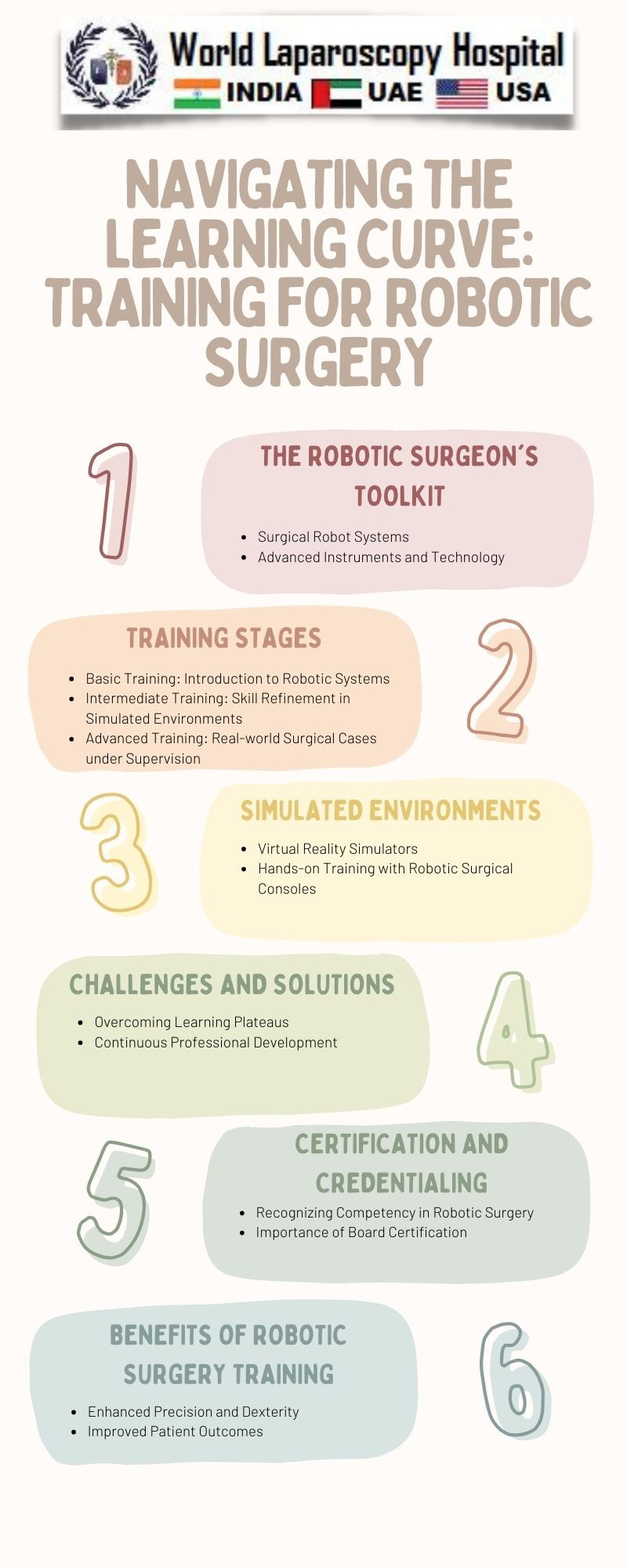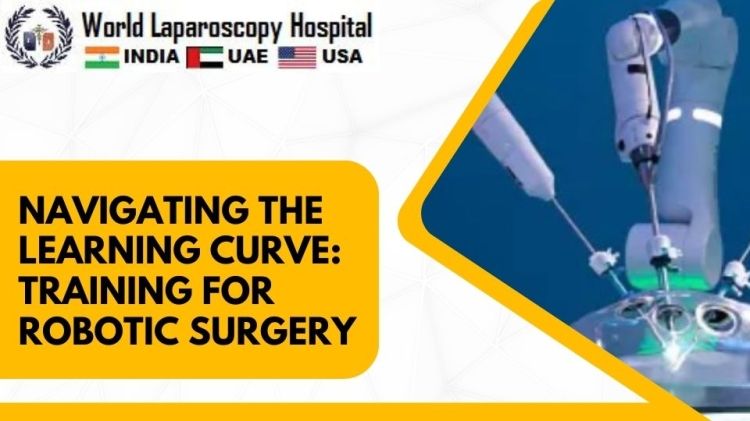Navigating the Learning Curve: Training for Robotic Surgery
Navigating the Learning Curve: Training for Robotic Surgery
Introduction:
Robotic surgery has revolutionized the field of medicine, offering unprecedented precision and dexterity to surgeons. However, harnessing the full potential of robotic-assisted procedures requires a thoughtful and systematic approach to training. This article will delve into the intricacies of navigating the learning curve associated with mastering robotic surgery, examining the challenges, strategies, and advancements that contribute to the evolution of surgical expertise.

The Rise of Robotic Surgery:
The integration of robotic technology into surgical procedures has witnessed a steady rise over the past decades. From minimally invasive techniques to complex surgeries, robots such as the da Vinci Surgical System have become indispensable tools in the hands of skilled surgeons. The advantages include smaller incisions, reduced blood loss, and quicker patient recovery times. However, these benefits come with the prerequisite of a steep learning curve.
Understanding the Learning Curve:
The learning curve in robotic surgery is multifaceted, encompassing technical proficiency, cognitive skills, and effective decision-making. Surgeons must adapt to the three-dimensional visual representation provided by the robotic console, master hand-eye coordination, and navigate the intricacies of the robotic arms' movements. The transition from traditional to robotic surgery demands a shift in mindset and the cultivation of new skills.
Structured Training Programs:
Structured training programs are fundamental in mitigating the challenges posed by the learning curve. These programs often incorporate a combination of didactic lectures, hands-on simulation exercises, and supervised clinical experiences. Surgical trainees progress through defined stages, gradually increasing the complexity of procedures as they gain proficiency. The emphasis on a stepwise approach helps build a solid foundation before tackling advanced robotic surgeries.
Simulation Technologies:
Simulation technologies play a pivotal role in honing the skills required for robotic surgery. Virtual reality (VR) and robotic simulators provide a risk-free environment where surgeons can practice and refine their techniques. These platforms allow trainees to familiarize themselves with the robotic console, practice instrument manipulation, and simulate various surgical scenarios. The feedback received during these simulations enhances self-awareness and accelerates the learning process.
Mentorship and Collaboration:
Mentorship is a cornerstone in the journey of mastering robotic surgery. Experienced robotic surgeons guide trainees through the nuances of the technology, sharing insights gained from their own experiences. Collaborative efforts, such as proctoring during initial procedures, foster a supportive learning environment. Peer collaboration also plays a vital role as surgeons exchange knowledge, discuss challenges, and collectively contribute to the evolution of best practices.
Challenges in Robotic Surgery Training:
Despite the advancements in training methodologies, challenges persist in the realm of robotic surgery education. Limited access to robotic systems, variability in program structures, and the need for continuous skill refinement pose ongoing hurdles. Addressing these challenges requires a concerted effort from medical institutions, industry stakeholders, and regulatory bodies to standardize training protocols and ensure widespread access to robotic surgical education.
Assessing Competency:
The assessment of surgical competency in the context of robotic procedures is a critical aspect of training. Traditional methods, such as case volumes and time-based criteria, may not adequately capture the nuances of robotic surgery. Objective metrics, including performance data from simulators and real-time monitoring of surgical skills, are emerging as more accurate measures of competency. Continuous assessment allows for targeted interventions to address specific areas of improvement.
Advancements in Robotic Surgical Training:
Technological advancements continue to enhance the landscape of robotic surgical training. Artificial intelligence (AI) is being integrated into simulation platforms, providing intelligent feedback and personalized training plans. Virtual reality programs are evolving to simulate realistic anatomical variations, challenging surgeons to adapt to diverse scenarios. These innovations not only accelerate the learning process but also contribute to the ongoing refinement of robotic surgery techniques.
The Human Element in Robotic Surgery:
While robotic surgery introduces cutting-edge technology, the human element remains paramount. Empathy, communication skills, and the ability to adapt to unforeseen challenges are indispensable qualities in a robotic surgeon. Integrating these aspects into training programs ensures that surgeons not only master the technical aspects but also deliver compassionate and patient-centered care.
Future Perspectives:
As robotic surgery continues to evolve, the future holds promising developments in training methodologies. Augmented reality, haptic feedback systems, and advancements in telemedicine are poised to further enhance the learning experience. Collaborative efforts between academic institutions, industry partners, and regulatory bodies will be crucial in shaping standardized, comprehensive, and accessible training programs for the next generation of robotic surgeons.
Conclusion:
Mastering robotic surgery is a journey that requires a commitment to continuous learning and adaptation. Navigating the learning curve involves a blend of structured training programs, simulation technologies, mentorship, and a keen focus on assessing and refining surgical competency. As technology advances, the collaboration between medical professionals, educators, and industry stakeholders becomes pivotal in shaping the future landscape of robotic surgery training. Ultimately, the goal is to empower surgeons to harness the full potential of robotic-assisted procedures, delivering precision and innovation in patient care.
Top
Introduction:
Robotic surgery has revolutionized the field of medicine, offering unprecedented precision and dexterity to surgeons. However, harnessing the full potential of robotic-assisted procedures requires a thoughtful and systematic approach to training. This article will delve into the intricacies of navigating the learning curve associated with mastering robotic surgery, examining the challenges, strategies, and advancements that contribute to the evolution of surgical expertise.

The Rise of Robotic Surgery:
The integration of robotic technology into surgical procedures has witnessed a steady rise over the past decades. From minimally invasive techniques to complex surgeries, robots such as the da Vinci Surgical System have become indispensable tools in the hands of skilled surgeons. The advantages include smaller incisions, reduced blood loss, and quicker patient recovery times. However, these benefits come with the prerequisite of a steep learning curve.
Understanding the Learning Curve:
The learning curve in robotic surgery is multifaceted, encompassing technical proficiency, cognitive skills, and effective decision-making. Surgeons must adapt to the three-dimensional visual representation provided by the robotic console, master hand-eye coordination, and navigate the intricacies of the robotic arms' movements. The transition from traditional to robotic surgery demands a shift in mindset and the cultivation of new skills.
Structured Training Programs:
Structured training programs are fundamental in mitigating the challenges posed by the learning curve. These programs often incorporate a combination of didactic lectures, hands-on simulation exercises, and supervised clinical experiences. Surgical trainees progress through defined stages, gradually increasing the complexity of procedures as they gain proficiency. The emphasis on a stepwise approach helps build a solid foundation before tackling advanced robotic surgeries.
Simulation Technologies:
Simulation technologies play a pivotal role in honing the skills required for robotic surgery. Virtual reality (VR) and robotic simulators provide a risk-free environment where surgeons can practice and refine their techniques. These platforms allow trainees to familiarize themselves with the robotic console, practice instrument manipulation, and simulate various surgical scenarios. The feedback received during these simulations enhances self-awareness and accelerates the learning process.
Mentorship and Collaboration:
Mentorship is a cornerstone in the journey of mastering robotic surgery. Experienced robotic surgeons guide trainees through the nuances of the technology, sharing insights gained from their own experiences. Collaborative efforts, such as proctoring during initial procedures, foster a supportive learning environment. Peer collaboration also plays a vital role as surgeons exchange knowledge, discuss challenges, and collectively contribute to the evolution of best practices.
Challenges in Robotic Surgery Training:
Despite the advancements in training methodologies, challenges persist in the realm of robotic surgery education. Limited access to robotic systems, variability in program structures, and the need for continuous skill refinement pose ongoing hurdles. Addressing these challenges requires a concerted effort from medical institutions, industry stakeholders, and regulatory bodies to standardize training protocols and ensure widespread access to robotic surgical education.
Assessing Competency:
The assessment of surgical competency in the context of robotic procedures is a critical aspect of training. Traditional methods, such as case volumes and time-based criteria, may not adequately capture the nuances of robotic surgery. Objective metrics, including performance data from simulators and real-time monitoring of surgical skills, are emerging as more accurate measures of competency. Continuous assessment allows for targeted interventions to address specific areas of improvement.
Advancements in Robotic Surgical Training:
Technological advancements continue to enhance the landscape of robotic surgical training. Artificial intelligence (AI) is being integrated into simulation platforms, providing intelligent feedback and personalized training plans. Virtual reality programs are evolving to simulate realistic anatomical variations, challenging surgeons to adapt to diverse scenarios. These innovations not only accelerate the learning process but also contribute to the ongoing refinement of robotic surgery techniques.
The Human Element in Robotic Surgery:
While robotic surgery introduces cutting-edge technology, the human element remains paramount. Empathy, communication skills, and the ability to adapt to unforeseen challenges are indispensable qualities in a robotic surgeon. Integrating these aspects into training programs ensures that surgeons not only master the technical aspects but also deliver compassionate and patient-centered care.
Future Perspectives:
As robotic surgery continues to evolve, the future holds promising developments in training methodologies. Augmented reality, haptic feedback systems, and advancements in telemedicine are poised to further enhance the learning experience. Collaborative efforts between academic institutions, industry partners, and regulatory bodies will be crucial in shaping standardized, comprehensive, and accessible training programs for the next generation of robotic surgeons.
Conclusion:
Mastering robotic surgery is a journey that requires a commitment to continuous learning and adaptation. Navigating the learning curve involves a blend of structured training programs, simulation technologies, mentorship, and a keen focus on assessing and refining surgical competency. As technology advances, the collaboration between medical professionals, educators, and industry stakeholders becomes pivotal in shaping the future landscape of robotic surgery training. Ultimately, the goal is to empower surgeons to harness the full potential of robotic-assisted procedures, delivering precision and innovation in patient care.






